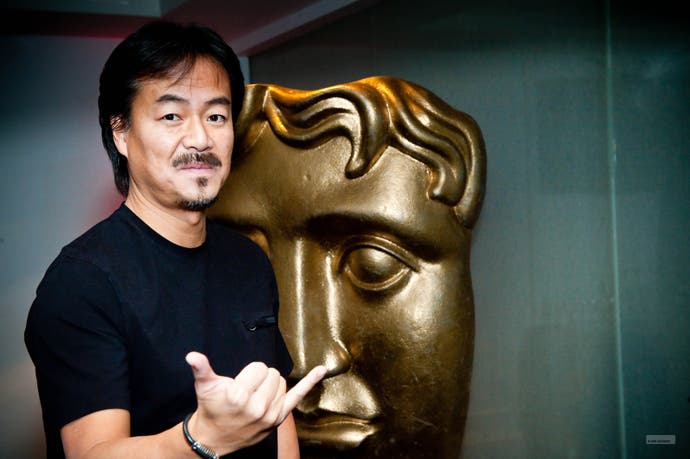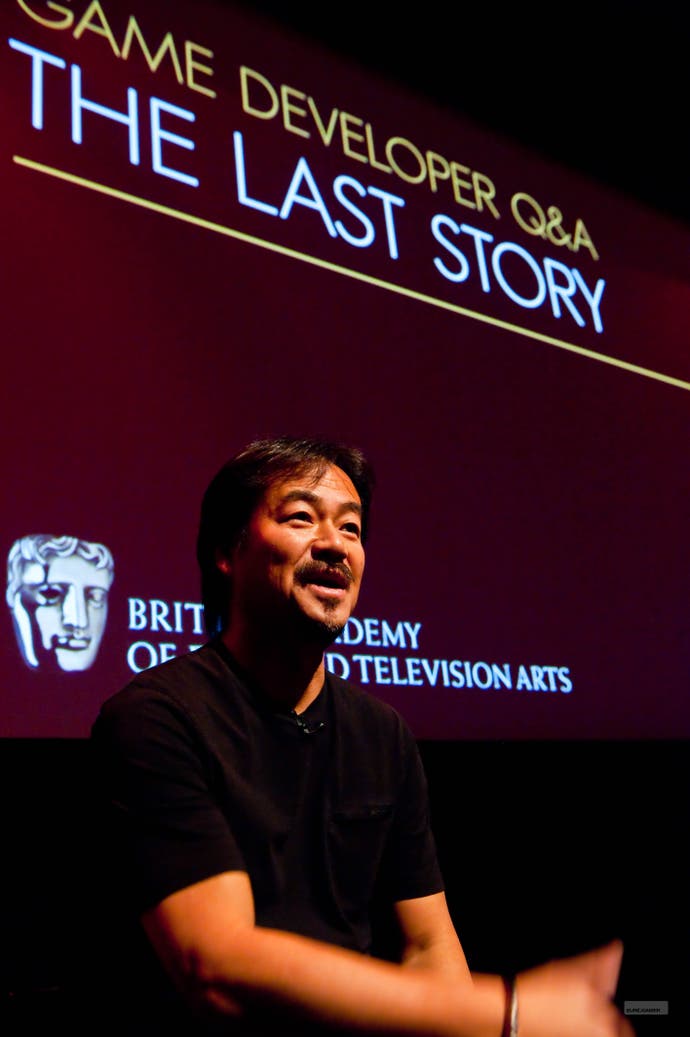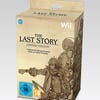Hironobu Sakaguchi: Fantasy Man
From the archive: He bet his career on a game and hit the jackpot, then bet it on a film and lost it all. What happened to Final Fantasy's father?
Every Sunday we offer up an article from our archive, either for you to discover for the first time or to get acquainted with all over again. This week we present Simon Parkin's profile of Hironobu Sakaguchi, originally published in February 2012.
"So, what are you doing in London today?" The hairdresser speaks in broken English, pausing every few words with the sheer effort of foreign sentence construction. "I am a video game journalist," I reply, hopefully. "Ahhh!" he laughs, a mixture of amusement and the relief of simply understanding the response.
"I just interviewed Hironobu Sakaguchi," I offer. A pause. "Do you know the Final Fantasy games? He made those."
I need a haircut, sort of, but really I came to this unassuming hairdressers near Oxford Street for this specific conversation. Never meet your heroes, they say: they can only disappoint. There's bruising truth in the cliché. When I was a teenager I would take the train to central London and walk through Soho to peer in the windows of Squaresoft's London office in the hope of catching a glimpse of a developer.
Of course, Golden Square was home only to weary marketing men, the company's creative teams housed thousands of miles away on two floors of the Phizer building in Shinjuku, Tokyo. There was never any chance of bumping into a Final Fantasy artist or Secret of Mana coder. Deep down maybe I suspected as much. If nothing else, video games make masters of suspension of disbelief of us all.
An hour earlier I stepped out of The Soho Hotel having sat down with the man whose games paid for that office in Golden Square and which inspired my stalking of it. But there's no sense of elation following the long-awaited meeting.

The preceding interview overran, cutting into an already tight schedule. A lunchtime dialogue became a 45-minute interview became a 30-minute race. Sakaguchi, jetlagged from his flight and weary from a morning answering the same questions worded differently, speaks in a slow and thoughtful Japanese drawl.
His translator writes copious notes as the director talks, processing the answers for a few seconds before assembling his mental translation. He gropes for words, occasionally referencing an electronic dictionary; answers that could take 30 seconds take five minutes to unfurl. Information remains coy under the ticking of a relentless clock.
By the end of the conversation, this treasure trove of anecdotes and facts feels almost untouched. Worse, when prompted by the Nintendo rep to bring things to a close with a final question I ask the 50-year-old Sakaguchi what he hopes to achieve with his remaining 15-odd years of working life. He pauses a dull pause.
Eventually: "There is nothing in particular that I want to achieve."
The suspension of disbelief crashes to the floor.
"I had so much fun when I first started at Square. During those days the development studio was in a rented apartment. Because I was so poor I'd often stay at their premises because they had a bath and air conditioning. I never really went home..."
Hironobu Sakaguchi
Ten minutes later I head to perhaps the only place within walking distance where there might be someone to help me replace disappointment with celebration. The hairdresser is staffed by young Japanese in their mid to late 20s, spending perhaps a year out in London before heading back to Tokyo to settle down. If meeting Hironobu Sakaguchi is still an occasion in 2012, then surely somebody here will recognise it as such.
"Ahhh!" says the hairdresser, smiling broadly. "I loved Final Fantasy 6!"
"Yes," I laugh, all relief. "Me too."
"So funny!" His face changes, quizzical. "His latest game. Final Fantasy...15? Or 14?"
"14," I say. "Well, 13 part two actually. But he wasn't invol..."
"I've not played that one," he laughs, not listening.
---
Hironobu Sakaguchi is a designer exceeded by one of his earliest creations. This rare press trip to the UK, the first in over a decade, is to promote his studio Mistwalker's latest Nintendo Wii title, The Last Story. Later that night, at a public BAFTA interview an audience member asks him if he's bored talking about Final Fantasy and he admits that, yes, after an afternoon being quizzed about the series by so many European journalists he is so very tired of it.
And yet, what a story.
Sakaguchi's first contact with a video game came soon after the birth of the industry, with Pong (although he forgets the name of the game when I ask him, instead acting out turning the dials used to move the proto-bat to swipe at the pixel ball). From there he bought an Apple II and played American role playing games such as Ultima and Wizardry, then later Transylvania by Penguin Software, games that pointed at a creative fissure he would later mine.
He joined Square - as the company was known at the time before it merged with long-time rival Enix to form an RPG super group - in 1983 and made three computer games, none of which excelled commercially. Soon afterwards he switched development to Nintendo's Famicom developing the racing game Highway Star, then King's Knight and World Runner.

"I had so much fun when I first started at Square," he tells me when I ask him to paint a picture of the early days. For the first time in the interview he becomes animated, makes eye contact and smiles. "During those days the development studio was in a rented apartment. Because I was so poor I'd often stay at their premises because they had a bath and air conditioning. I never really went home..."
His formative titles sold reasonably well but Sakaguchi wasn't excited by the designs ("The reason these games failed to do better was because I was copying what was already on the market"). His bosses had assigned him to make 3D games for the system because the programmer working with him, Nasir Gebelli, excelled at 3D graphic coding.
Sakaguchi resolved to try one last project in the emerging genre that first attracted him to the industry. He wrote the design document for Final Fantasy, labelling the project with a name that reflected the fact he expected this to be his final video game project, his first and last story.
It wasn't. Final Fantasy launched with perfect timing, riding the swell of RPG popularity kicked up by Black Onyx (the first Japanese RPG, introduced to the country by Bulletproof Software's Henk Rogers) and Enix's own Dragon Quest. Final Fantasy found a vociferous following, first in Japan, then in America following the release of Final Fantasy 6 and, finally, in Europe following the release of Final Fantasy 7.
As the company moved from its rented apartment to multinational offices, Sakaguchi sought out Japan's brightest talent, hiring people such as Tetsuya Nomura, the artist who designed Cloud and Aeris and whose art style now defines Square Enix's Japanese output; Tetusya Takahashi, designer of Xenogears and last year's triumphant Xenoblade Chronicles and Yasumi Matsuno, creator of Ogre Battle, Final Fantasy Tactics and Vagrant Story.
Sakaguchi had a knack for partnering with keen talent; even Ted Woolsey, the man tasked with translating many of the company's 16-bit titles within punishing deadlines (Final Fantasy 6 was reportedly translated in just 30 days) is now director of first party publishing for Microsoft's Xbox Live Arcade service.

These were the golden years, arguably the most productive and creatively rich in the company's history. Fascinating curios such as Bahamut Lagoon, Brave Fencer Musashi, Racing Lagoon, and Dew Prism refute the lie that Squaresoft was a one trick Chocobo. Rarely has a publisher pressed its nose against the boundaries of its chosen genre with such force and abandon.
The publisher even set up its own 'indie' label, the anagrammatically-named Aques, to release non-JRPGs during the PlayStation years. But with all that success came hubris and, having fantasised for so many years about making games masquerading as films, Sakaguchi was finally offered the chance to make a film masquerading as a game.
Final Fantasy: The Spirits Within was a movie directed by a man whose sole experience of directing was in video game cut-scenes, the 45-second CGI money-shots that brought the rudimentary sprites used in gameplay to life. No animated movie before or after its release has lost more money at the box office (the movie cost $137 million and took just $85 million worldwide). Regardless of how much money Sakaguchi had brought to the Square empire, the movie's failure undermined his position as director at the company to shareholders, reportedly delaying the merger deal with Enix by several years.
The headlines, real or imagined, became 'Square - the Japanese game maker with ideas above its station'; 'Square - not good enough for Hollywood'. In 2004 Sakaguchi stepped down from his position as an executive vice president at the company he built. A Japanese game reporter once told me that, following the director's departure, those creative minds he had mentored within the company were ostracised by the new management. Midway through development of Final Fantasy 12 Sakaguchi's protégée, producer Yasumi Matsuno, departed citing "ill health", never to return.
"I am always most excited about the now. It's always the current moment that is the most exciting in game development. Of course the techniques that are used in game creation and theory are always evolving. When I first started in the industry I could never have imagined games would look the way that they do today. So I am excited for today. But also I am excited for tomorrow."
Hironobu Sakaguchi
Sakaguchi retired to Hawaii, where he still lives today, surfing and dreaming up ideas for video games ("the idea for the 'gathering' mechanic in The Last Story came to me while I was waiting for a wave"). His reputation ensured that by the time his no-compete clause with Square Enix was up, Microsoft was at his front door holding a chequebook and invitation to come aboard. Together they formed Mistwalker studios, based in Tokyo yet managed by Sakaguchi from Hawaii. Development began on two Xbox 360 exclusives: Blue Dragon and Lost Odyssey.
Sakaguchi was back in the game. But what had been lost in the fire?
---
"Whenever I create a game it's still like my own child is being born," he tells me. "The Last Story took three and a half years to complete and all of the staff members put their all into creating the game. Our child is extremely beautiful. We have a lot of love for the game. I am extremely satisfied with the outcome."
There's a passion in his words that goes beyond a fulfilment of marketing duty. The Last Story, a competent, interesting Japanese RPG may not be his best work, but it's no runt of the litter. And to characterise Sakaguchi as an absent father would be grossly unfair. He is still present and hands on in the creative birthing process, to play on his own analogy.
"Normally I would spend three weeks in Hawaii followed by three weeks in Japan during a development," he says. "But for The Last Story I spent three months in Tokyo followed by just 10 days in Hawaii, a repeating pattern for three years. Even though we have video chat these days I still prefer to be in front of the team."
Beyond scratching that creative itch, Sakaguchi is eager to continue to gently but forcibly push the genre he helped establish. The first year of The Last Story's production was given over to prototyping. "The game was born from the feeling that we need to move away from the traditional turn based combat of JRPGs," he says. "We had a trial and error phase that lasted a year where we just tried different approaches. A lot of those ideas were rejected but many were adopted."
Even so, with the JRPG long fallen from its dizzy commercial heights of success in the 32-bit era, it's difficult to imagine Sakaguchi could be as excited about games as he has been at other pivotal times in his long-running career.
"I am always most excited about the now," he counters. "It's always the current moment that is the most exciting in game development. Of course the techniques that are used in game creation and theory are always evolving. When I first started in the industry I could never have imagined games would look the way that they do today. So I am excited for today. But also I am excited for tomorrow."
Ands that's when I ask him about his own future; about his own ambitions and goals.
The long pause.
"There's nothing in particular that I want to achieve. I want to enjoy the moment, have fun as I go alone." And why shouldn't he? Here is a man who bet everything on a game, a fantasy, and hit the jackpot. Here is a man who bet everything on a film, a fantasy, and lost it all again. Here is a man who, thanks to his legacy, now runs a company that can make the games that pop into his head while he surfs on a beach in Hawaii. Here is a man whose legacy means two people from different walks of life and from different ends of the earth can share a laugh in a hairdressers' salon about a game that was released 18 years ago.
It doesn't matter that the hairdresser doesn't know Sakaguchi isn't working on Final Fantasy any more. Hironobu Sakaguchi is a designer exceeded by one of his creations. If indeed he views his games as his children, then no man wants more for his children than a story greater than his own.
At home that night I begin to transcribe the interview. The .mp3 reaches the question about future ambition, and I realise that I'd stopped listening before the translator had finished the thought. "There are times when I suddenly come up with an idea," he added. "I've always felt that when you are gifted with an idea you have a responsibility to carry it through, to make it into something."
For Sakaguchi the creative process is not an ambition; it is a duty, a responsibility. And while that continues to remain his attitude, there will be no ending, merely the opportunity for another final fantasy, and another again.











